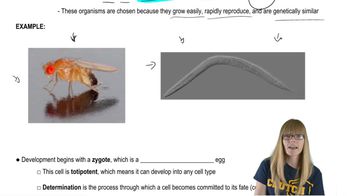Hereditary spherocytosis (HS) is a disorder characterized by sphere-shaped red blood cells, anemia, and other abnormal traits. Ankyrin-1 (ANK1) is a protein that links membrane proteins to the cytoskeleton. Loss of this activity is associated biochemically to HS. However, Gallagher et al. (2010) (J. Clin. Invest. 120:4453–4465) show that HS can also be caused by mutations within a region from -282 to -101 relative to the transcriptional start site, which lead to constitutive transcriptional repression in erythroid cells due to local chromatin condensation. Propose a hypothesis for the function of the -282 to -101 region of the ANK1 gene.
Table of contents
- 1. Introduction to Genetics51m
- 2. Mendel's Laws of Inheritance3h 37m
- 3. Extensions to Mendelian Inheritance2h 41m
- 4. Genetic Mapping and Linkage2h 28m
- 5. Genetics of Bacteria and Viruses1h 21m
- 6. Chromosomal Variation1h 48m
- 7. DNA and Chromosome Structure56m
- 8. DNA Replication1h 10m
- 9. Mitosis and Meiosis1h 34m
- 10. Transcription1h 0m
- 11. Translation58m
- 12. Gene Regulation in Prokaryotes1h 19m
- 13. Gene Regulation in Eukaryotes44m
- 14. Genetic Control of Development44m
- 15. Genomes and Genomics1h 50m
- 16. Transposable Elements47m
- 17. Mutation, Repair, and Recombination1h 6m
- 18. Molecular Genetic Tools19m
- 19. Cancer Genetics29m
- 20. Quantitative Genetics1h 26m
- 21. Population Genetics50m
- 22. Evolutionary Genetics29m
15. Genomes and Genomics
Functional Genomics
Problem 21a
Textbook Question
The eyes of Drosophila develop from imaginal discs, groups of cells set aside in the fly embryo that differentiate into the adult structures during the pupal stage. Despite their importance in nature, eyes are dispensable for fruit fly life in the laboratory.
Devise a genetic screen to identify genes directing the development of the fly eye.
 Verified step by step guidance
Verified step by step guidance1
Understand the goal of the genetic screen: The objective is to identify genes involved in the development of the Drosophila eye. This requires creating a system to detect mutations that disrupt normal eye development.
Choose a mutagenesis method: Use a mutagen, such as ethyl methanesulfonate (EMS), to induce random mutations in the genome of Drosophila. This will create a population of flies with potential mutations in various genes.
Set up the genetic screen: Cross mutagenized male flies with wild-type females to produce offspring. Screen the progeny for phenotypes that indicate abnormal eye development, such as missing eyes, reduced eye size, or irregular eye structure.
Confirm the genetic basis of the phenotype: Perform additional crosses to ensure that the observed eye phenotype is heritable and linked to a specific mutation. This may involve backcrossing to wild-type flies and analyzing the segregation of the phenotype in subsequent generations.
Map and identify the mutated gene: Use genetic mapping techniques, such as recombination frequency analysis or molecular tools like whole-genome sequencing, to pinpoint the location of the mutation. Once the gene is identified, study its function to understand its role in eye development.
 Verified video answer for a similar problem:
Verified video answer for a similar problem:This video solution was recommended by our tutors as helpful for the problem above
Video duration:
2mPlay a video:
Was this helpful?
Key Concepts
Here are the essential concepts you must grasp in order to answer the question correctly.
Imaginal Discs
Imaginal discs are clusters of undifferentiated cells in the larval stage of Drosophila that later develop into adult structures, including the eyes. These discs are crucial for understanding how specific genes influence the formation of complex organs during metamorphosis, as they serve as the precursors to adult tissues.
Recommended video:
Guided course

Supercoiling
Genetic Screening
Genetic screening is a method used to identify and isolate specific genes associated with particular traits or developmental processes. In the context of Drosophila eye development, researchers can use mutagenesis or RNA interference to create variations in the genome, allowing them to pinpoint genes that affect eye formation by observing phenotypic changes.
Recommended video:
Guided course

Descriptive Genetics
Pupal Stage Development
The pupal stage is a critical phase in the life cycle of Drosophila where significant morphological changes occur, transforming the larva into an adult fly. Understanding this stage is essential for studying eye development, as it is during this time that the imaginal discs differentiate into functional structures, influenced by the expression of specific developmental genes.
Recommended video:
Guided course

Genetics of Development
Related Videos
Related Practice
Textbook Question
699
views


